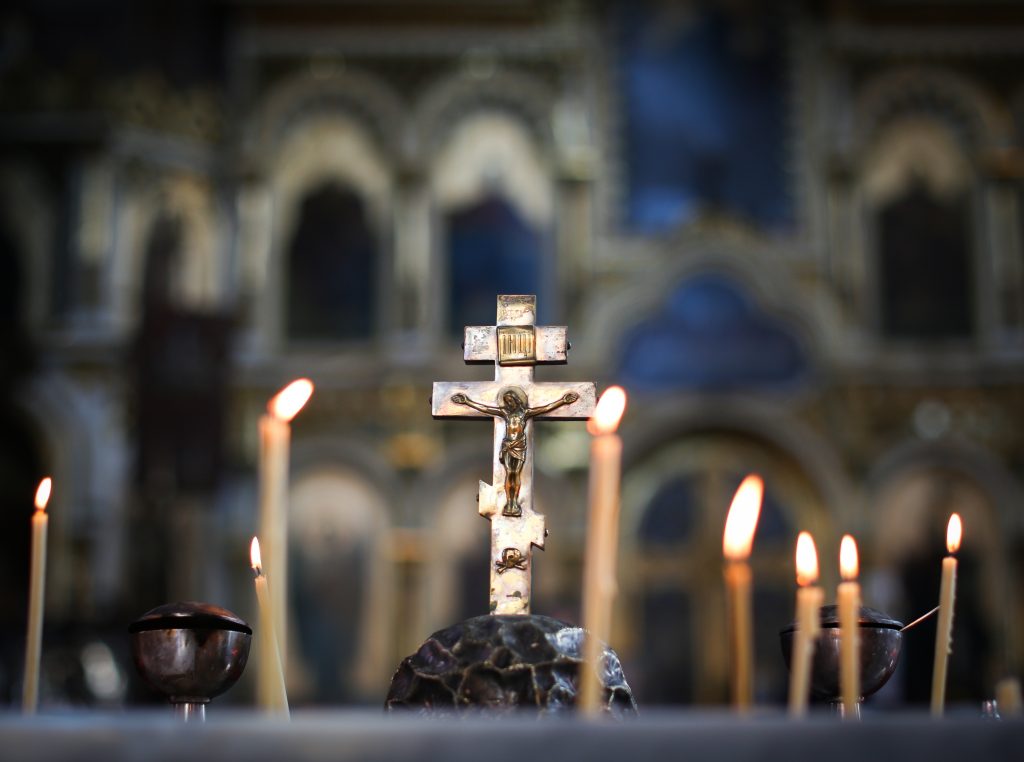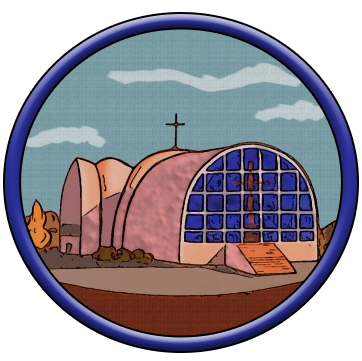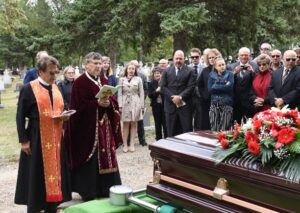Funeral Rites

Humans were not created for death. Humanity was created to live forever by God’s grace, in an intimate fellowship with God. However, when Adam and Eve sinned and disobeyed God, this relationship was severed. Through sin, humanity became cut off from the source of life, and death came into the world.
The experience of death is a part of the fallen world. However, we have the promise that this condition is not permanent. Because of Christ’s death and resurrection, we know that death is not the absolute end to our existence. Our faith in the Lord assures us that He will resurrect us once again, reuniting our body and soul. Our transformed bodies will be taken to heaven, where they will no longer be vulnerable to pain, sickness, and death.
From the very beginning the Church has prayed for the dead. Prayers are offered because as members of the Church we are obligated to pray for each other and therefore we pray not only for the living, but for the dead. Our memorial prayers remind us of our own eventual death and our responsibility to prepare for it.
The Ukrainian rite funeral typically consists of four events:
- A prayer service, a Parastas or Panakhyda, is celebrated on the eve of the funeral either in the funeral home or the church. The vigil is a long-standing custom that enables the bereaved to pray for the deceased and to reflect on the Christian meaning of life as God created it. The service may be held in the church or funeral home. The service typically ends with a viewing of the body. The family may invite those in attendance for coffee and sweets following the service.
- The Requiem Divine Liturgy begins with the reception of the funeral procession at the entrance of the church. The clergy incenses the body and reads a passage from one of the four gospels. The clergy then leads the pallbearers and family with the casket into the church. The casket is placed at the foot of the sanctuary. The family and pallbearers are seated in the front pews. The Requiem Divine Liturgy includes psalms and scripture readings that draw attention to God’s work and the importance of the Divine Eucharist as spiritual nourishment. The entire service is usually sung. Incense is commonly used as a symbol of prayers rising to God.
- The burial or internment takes place at the cemetery in the context a Panakhyda. The priest then casts earth and ashes upon the casket as a reminder that we are all earth, dust and ashes and that, according to the will of God, we will return to the earth once again. The priest then makes the sign of the cross at the head, feet and both sides of the casket, thus symbolically sealing the grave until the second coming of the Lord, Jesus Christ.
- A memorial lunch (tryzna) provides an opportunity for friends and family to share memories, and express condolences.
Important elements:
Praying for the dead: From the time of the Apostles, Christians have offered prayers for the dead. They are offered because the Church is one, consisting of members both on earth (called the “Church Militant”) and in heaven (the “Church Triumphant”).
The open casket: During the funeral service the remains are blessed with holy water, and the absolution prayer is read. At the end of the service, the faithful proceed to the coffin to give a final farewell to the departed. These are powerful statements of our belief and would not be possible should the casket be closed.
The Church in its wisdom understands the importance of the bereaved of seeing the body of the departed and of getting closure from the good-byes.
Psalms: Integral to the funeral services is the chanting of psalms of the Old Testament. Three sets of verses with refrains from Psalm 118 (119) speak of God’s great goodness and our utter dependence upon Him and His Law, which guides us through all the days of our life. Psalm 50 (51), a prayer of repentance, appeals to God’s steadfast love, compassion and gracious mercy for cleansing and forgiveness.
Saints: As well as praying to the Lord directly, we also ask His Saints to intercede on behalf of the departed loved one.
The Absolution: This is a prayer that is read over the deceased asking God to forgive every sin that the person committed throughout his/her entire life, whether known or unknown, and whether committed in malice or weakness.
Braided Bread and Fruit: Jesus said, “I am the bread of life.” This reality is expressed by the use of bread during the funeral. The bread is circular in form symbolizing eternity. A candle, symbolizing Christ, the light of the world, is placed in the center. The fruit reminds us not only to be Christians in faith, but also to produce the fruit of good works.
Eternal Memory: This is hymn is taken from the Gospel accounts of Jesus’ crucifixion. The Lord is crucified with two thieves, one of whom repents and says,” Remember me when You come into Your Kingdom.” (Luke 23:42) As we sing “Eternal memory” for our departed, we are saying, “Remember them, Lord, when You come into Your Kingdom”.
The Final Farewell or Last Kiss: This is the time when the people are asked to say farewell to the mortal remains of the departed.
In its essence, the Funeral rite is a service of Resurrection, a service of thanksgiving for the passage from physical life into the fullness of life in the embrace of the Holy Trinity!
Adapted with appreciation from these sources:
Funeral services of the Ukrainian Catholic Church
Funeral Services by the Metropolitan Cantor Institute
The Parastas and the Panakhyda
Memorial Services
The Parastas “(standing service”) is a memorial service for the dead in the Byzantine-Slav tradition. It is also called the “Great Panakhyda”; the (small) Panakhyda forms the conclusion of the Parastas.
The Parastas is as a service of prayer for those who have died and gone forth to God’s judgment. As such, the Parastas is appointed for the five All Souls Saturdays, after the Divine Liturgy, and may also be celebrated on the anniversaries of the deaths of those we love, or on common commemorations such as Remembrance Day.
The ancient Christian tradition of keeping watch or vigil, as well as the basic human desire to accompany the dead to their rest, lie behind the custom of reading the psalter during the night before a burial (for a priest, the Gospel is read). The Parastas is often celebrated in the funeral home as a similar sort of vigil service over the body of the one who has died.
Due to the length of the Parastas, the Panakhyda is sometimes celebrated instead.
Adapted with appreciation from: The Memorial Service (Parastas) by the Metropolitan Cantor Institute
The Panakhyda is one of our most important services outside of the Divine Liturgy, celebrated fairly frequently in the Ukrainian Catholic Church. This service is held several times as part of the funeral and graveside services for one who has died, and may be celebrated after the Divine Liturgy, particularly on All Souls Saturdays or on the anniversary of the death of a loved one.
Like all our services for the departed, it provides an opportunity to pray for the soul of the one who has died, asking God to grant them rest and forgiveness of all their sins, and serves to comfort and console those left behind. The name comes from the Greek pannychis, meaning an all-night vigil.
The Panakhyda is ordinarily celebrated:
- Immediately after the death of a Christian, if a priest is present (the prayers for the dying, together with the panakhyda, make up the “Office at the Passing of the Soul”)
- Before the body of the departed Christian is taken to the church for burial
- After the burial, as a graveside service
- On the 40th day after death, and each year thereafter. In these cases, it may immediately follow a Divine Liturgy celebrated for the departed.
- At graveside blessing during the season of Pentecost
The Panakhyda also forms the concluding part of a longer memorial service for the dead, the Parastas.
The structure of the Panakhyda consists of:
- An opening blessing: “Blessed is our God….”
- The usual “beginning prayers”, from “Holy God” through the Lord’s Prayer.
- Troparia for the dead (“With the just souls who have reached their end…”)
- Litany for the Deceased, concluding with the prayer, “O God of spirits and of all flesh.”
- Dismissal
- “Вічная Пам’ять” “Everlasting Memory”
The complete text of the Panakhyda can be found in our Divine Liturgy books on page 133.
Adapted with appreciation from: The Panachida by the Metropolitan Cantor Institute

